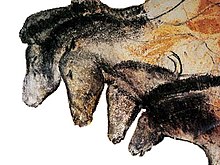
Back كهف شوفيه Arabic كهف شوفيه ARZ Şove mağarası Azerbaijani Goa Chauvet BAN Пячора Шавэ Byelorussian Пячора Шавэ BE-X-OLD Шове Bulgarian Kev Chauvet Breton Cova de Chauvet Catalan Chauvet-Pont-d'Arc Cave CEB
| UNESCO World Heritage Site | |
|---|---|
 | |
| Location | Ardèche, France |
| Criteria | I,III,V,VI,VII,VIII,X |
| Reference | 1426 |
| Inscription | 2014 (38th Session) |
| Area | 9 ha |
| Buffer zone | 1,353 ha |
| Website | archeologie |
| Coordinates | 44°23′15″N 4°24′51″E / 44.38750°N 4.41417°E |
The Chauvet-Pont-d'Arc Cave (French: Grotte Chauvet-Pont d'Arc, French pronunciation: [ɡʁɔt ʃovɛ pɔ̃ daʁk]) in the Ardèche department of southeastern France is a cave that contains some of the best-preserved figurative cave paintings in the world,[1] as well as other evidence of Upper Paleolithic life.[2] It is located near the commune of Vallon-Pont-d'Arc on a limestone cliff above the former bed of the river Ardèche, in the Gorges de l'Ardèche.
Discovered on December 18, 1994, it is considered one of the most significant prehistoric art sites and the UN's cultural agency UNESCO granted it World Heritage status on June 22, 2014.[3] The cave was first explored by a group of three speleologists: Eliette Brunel-Deschamps, Christian Hillaire, and Jean-Marie Chauvet for whom it was named six months after an aperture now known as "Le Trou de Baba" ("Baba's Hole") was discovered by Michel Rosa (Baba).[4] At a later date the group returned to the cave. Another member of this group, Michel Chabaud, along with two others, travelled further into the cave and discovered the Gallery of the Lions, the End Chamber. Chauvet has his own detailed account of the discovery.[5] In addition to the paintings and other human evidence, they also discovered fossilized remains, prints, and markings from a variety of animals, some of which are now extinct.
Further study by French archaeologist Jean Clottes has revealed much about the site. The dates have been a matter of dispute but a study published in 2012 supports placing the art in the Aurignacian period, approximately 32,000–30,000 years ago. A study published in 2016 using additional 88 radiocarbon dates showed two periods of habitation, one 37,000 to 33,500 years ago and the second from 31,000 to 28,000 years ago, with most of the black drawings dating to the earlier period.
- ^ UNESCO. [1], June 2014.
- ^ Clottes (2003b), p. 214.
- ^ France 24. "UNESCO grants heritage status to prehistoric French cave" Archived 2018-01-07 at the Wayback Machine, June 2014.
- ^ Hammer, Joshua (April 2015). "Finally, the Beauty of France's Chauvet Cave Makes its Grand Public Debut". Smithsonian. Smithsonian Institution. Retrieved 20 August 2018.
- ^ Chauvet, Jean-Marie; Deschamps, Eliette Brunel; Hillaire, Christian; Clottes, Jean; Bahn, Paul (1996). Dawn of art : the Chauvet Cave : the oldest known paintings in the world. New York: H.N. Abrams. ISBN 0-8109-3232-6.
© MMXXIII Rich X Search. We shall prevail. All rights reserved. Rich X Search
